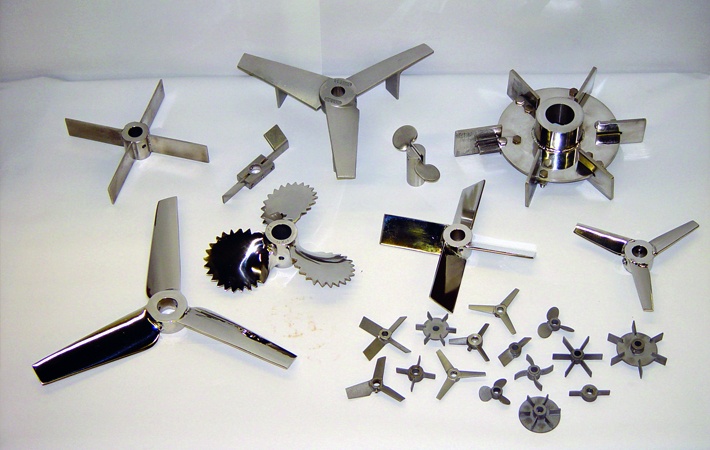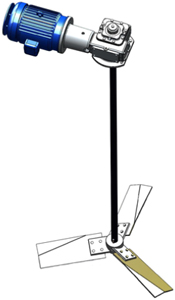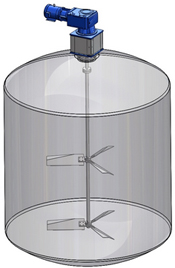
 We get questions from customers about industrial mixing all the time. So we gathered the top 5 frequently asked questions and took them to Sean Donkin, President and CEO of Cleveland Mixer, to get them answered.
We get questions from customers about industrial mixing all the time. So we gathered the top 5 frequently asked questions and took them to Sean Donkin, President and CEO of Cleveland Mixer, to get them answered.
Each type of tank has its advantages and disadvantages. One of the great things about square tanks is that the corners of the tank can act as baffles, allowing for the transfer of the agitator’s power to be invested more effectively into the liquid. The imposition of the agitator’s torque into the process fluid causes dynamic process response. This in turn yields an axial flow pattern and uniformity in the fluid media. Keep in mind, the fabrication costs of a square or rectangular tank might not be competitive compared to cylindrical tank.
Cylindrical tanks on the other hand, can have a stronger design, but will typically require baffles when the mixer is center and vertically mounted.
Excellent mixing results can be accomplished in either square or round tanks. As long as the mixer application engineer knows which will be used, they can ensure the mixer and tank design work together to achieve the overall process goals.
Sometimes, depending on the situation. For example, if your mixer is vertically and center mounted, and you’re mixing a low viscosity fluid, you will most likely need baffles to achieve an optimal axial flow pattern.
However, if you’re mixing a high or medium viscosity fluid, baffles may not be required because there may be enough resistance for the mixer to impose all of its torque on the fluid.
In summary, it is the impeller Reynolds Number (Ratio of imposed forces compared to viscous forces) that ultimately decides the use of baffles.
Mixing without baffles in a round tank.
Mixing with baffles in a round tank.

Not necessarily. The use of a multiple impeller system is governed by the liquid level compared to the tank diameter. As a general rule of thumb, when the liquid level is 1.2 times that of the tank diameter or greater, normally two impellers would be considered. Other considerations would be the differences in specific gravity of the fluids to be mixed or if they are hydrophobic.
When adding a second impeller, the output flow produced by the mixer is not doubled. Rather, there is approximately a 35 to 40% increase in overall mixer output.
Generally speaking, using more impellers does not mean you’ll get a better mix, but sometimes tank geometry demands it. If you’re using a tall cylinder with a small diameter, you’ll probably need more than one impeller.
What are some of the issues with adding a VFD to increase the mixer’s speed?
Using a Variable Frequency Drive (VFD) on mixer offers a lot of operational flexibility and benefits. It can act as a motor starter, monitor amperage to the mixer, as well as adjust mixer speed as the tank is filling or draining.
But there are a few issues that can arise when increasing the mixer speed with a VFD. Before installing a VFD, decide if the motor and gear reducer will be are rated for VFD use. Over speeding a motor can reduce bearing life and will increase amp draw. Over speeding a gear reducer will reduce bearing life and cause additional wear on the input gearing without sufficient service factor. Again, the important consideration is that the mixer, tank and process operation must be synthesized. The mixer application engineer’s role is to insure that the process goals are met effectively while maintaining a very high level of mechanical integrity in the mixer system.
Ever had a tough mixing challenge? Tell us about it in the comments below. If you’re facing a tough mixing challenge now, ask us about it! We gladly provide technical assistance to businesses in Wisconsin and Upper Michigan.
These Stories on Mixing
Headquarters and Service Center
Located outside Green Bay, WI
707 Ford Street
Kimberly, WI 54136
920-733-4425
OptiFlow Design and Build Center
1002 Truman Street
Kimberly, WI 54136
920-733-4425
Burnsville Service Center
12265 Nicollet Avenue
Burnsville, MN 55337
952-444-1949
Grand Rapids Service Center
26489 Industrial Blvd
Cohasset, MN 55721
952-444-1949
© Copyright 2024. Crane Engineering. All Rights Reserved. Privacy Policy.